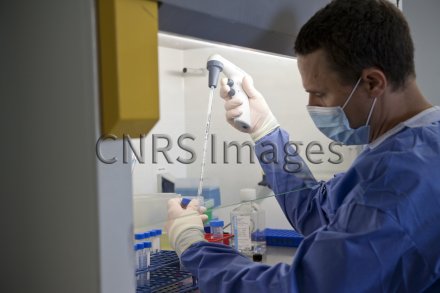Production year
2017

© Christophe HARGOUES / IGH / CNRS Images
20170072_0001
Handling a blood sample from a patient infected with HIV-1 in a BSC (biosafety cabinet) in the P3 laboratory at the Institute of Human Genetics (IGH). All the peripheral blood mononuclear cells (PBMC) are collected in order to mark them with a specific antibody. The PBMC ring (formed element of the blood: mainly leucocytes) has been separated from the red blood cells and the plasma. The PBMC contain both healthy cells (the vast majority) and infected cells (very rare). It is in this laboratory that a marker has been identified that makes it possible to differentiate between dormant or reservoir cells, infected with HIV, and healthy cells. This discovery will make it possible to isolate and analyse these reservoir cells which, by silently hosting the virus, are responsible for its persistence even in patients receiving antiretroviral treatment, whose viral load is undetectable. It offers new therapeutic strategies for targeting infected cells.
The use of media visible on the CNRS Images Platform can be granted on request. Any reproduction or representation is forbidden without prior authorization from CNRS Images (except for resources under Creative Commons license).
No modification of an image may be made without the prior consent of CNRS Images.
No use of an image for advertising purposes or distribution to a third party may be made without the prior agreement of CNRS Images.
For more information, please consult our general conditions
2017
Our work is guided by the way scientists question the world around them and we translate their research into images to help people to understand the world better and to awaken their curiosity and wonderment.